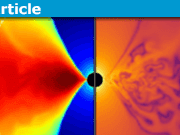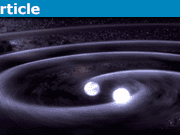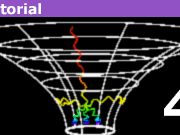An Equation for the Centrifugal Force Reversal Near A Black Hole
My goal in this article is to derive a simple equation for the proper acceleration of an observer traveling on a circular path around a Schwarzschild black hole at some constant radius [itex]r > 2M[/itex]. (Note that this is not the same as being in a stable circular orbit about the hole; we allow for “orbits” that require nonzero rocket thrust to maintain, and we won’t look at stability under small perturbations since we’ll assume the orbit can be corrected, if needed, by rocket thrust.) This is, of course, a restricted answer since it doesn’t cover trajectories that change radius; but this simple, quick analysis will illustrate at least one way in which centrifugal force does “reverse” close to a black hole.
The simplest way to study the worldlines we’re interested in is to define a 4-velocity field for “orbiting observers”, in terms of the standard Schwarzschild coordinate chart for the exterior region outside the black hole’s horizon (as should be evident, we are working in units where ##G = c = 1##):
[tex]u^a = \frac{1}{\sqrt{1 – \frac{2M}{r}} \sqrt{1 – v^2}} \partial_t + \frac{v}{r \sqrt{1 – v^2}} \partial_{\phi}[/tex]
where [itex]M[/itex] is, of course, the mass of the hole, and [itex]v[/itex] is the tangential velocity of the observer (which we’ll assume is constant for any particular orbit), as measured in the local inertial frame of a “static” observer (i.e., one who is “hovering” at constant r with zero angular momentum about the hole). Note that we are assuming an equatorial “orbit”, so [itex]\theta = \pi / 2[/itex] and we can ignore factors of [itex]\sin \theta[/itex]. We can sanity check this by plugging in [itex]v = 0[/itex] and seeing that the resulting 4-velocity is indeed that of the static observer.
Now we simply compute the path curvature of this 4-velocity field; the 4-acceleration vector is:
[tex]a^a = u^b \nabla_b u^a = u^b \partial_b u^a + u^b \Gamma^a{}_{bc} u^c[/tex]
and the magnitude of the 4-vector, which is what will actually be measured by an accelerometer carried by the “orbiting observer”, is
[tex]a = \sqrt{g_{ab} a^a a^b}[/tex]
Expanding out the vector components, we find that only the r component is nonzero, so the magnitude of the 4-acceleration becomes:
[tex]a = \sqrt{g_{rr}} a^r = \sqrt{g_{rr}} \left( \Gamma^r{}_{tt} u^t u^t + \Gamma^r{}_{\phi \phi} u^{\phi} u^{\phi} \right)[/tex]
Substituting, we obtain
[tex]a = \sqrt{\frac{r}{r – 2M}} \left( \frac{M}{r^2 \left( 1 – v^2 \right)} + \frac{\left( 2M – r \right) v^2}{r^2 \left( 1 – v^2 \right)} \right)[/tex]
We can refactor this into a form that will make the physical interpretation easier:
[tex]a = \frac{M}{r^2 \sqrt{1 – \frac{2M}{r}}} \left[ \frac{1 – \left( \frac{r}{M} – 2 \right) v^2}{1 – v^2} \right][/tex]
Now we can see what’s going on here. If we again take [itex]v = 0[/itex], we recover the standard formula for the proper acceleration of a “hovering” observer, as we should (another sanity check). For nonzero [itex]v[/itex], we can see that there are three regimes that have different physical behavior:
r > 3M
In this regime, for small [itex]v[/itex], [itex]a[/itex] is positive; that is, an observer “orbiting” at low speed will need outward rocket thrust to maintain a constant altitude. As [itex]v[/itex] increases, the thrust required decreases, until a point is reached where the thrust goes to zero. Obviously, this corresponds to a free-fall orbit, and the free-fall orbital velocity is given by:
[tex]v_{orbit} = \sqrt{\frac{1}{\frac{r}{M} – 2}}[/tex]
As one more sanity check, we note that for large r, we can neglect the 2 under the square root and we get [itex]v_{orbit} = \sqrt{M / r}[/itex], the standard Newtonian result (or [itex]v = \sqrt{GM / r}[/itex] in conventional units).
For [itex]v[/itex] larger than the orbital velocity, [itex]a[/itex] is negative; that is, we now require inward rocket thrust to maintain altitude. (I believe this is called a “forced orbit” in astronautics.) The inward rocket thrust required goes to infinity as [itex]v[/itex] goes to 1 (i.e., as tangential speed approaches the speed of light).
All this, of course, is the standard “centrifugal force” behavior that matches our intuitions. (We note in passing that for [itex]r < 6M[/itex], the free-fall orbit is no longer stable; but as I said at the start, we aren’t considering stability since we are allowing for rocket thrust to adjust the orbit. If you like, you can consider the value of [itex]a[/itex] we are calculating as an average over many orbits, allowing for small time-varying adjustments.) But in the other two regimes, things get more interesting.
r = 3M
At this radius, we find that [itex]a[/itex] is independent of [itex]v[/itex]! That is, any object orbiting the hole at this radius, regardless of its tangential velocity, must exert the same outward rocket thrust to maintain altitude. This may seem a bit confusing since we know that at this radius, photons can orbit the hole on null geodesics (i.e., “free-fall” orbits). But remember that we are working with a 4-velocity field, i.e., with a unit timelike vector, so our results don’t apply to photons. This is an example, in fact, of a case where the behavior of photons is discontinuous with the behavior of timelike objects.
(There is another sense in which the photon behavior at [itex]r = 3M[/itex] is not discontinuous with timelike behavior; as [itex]r[/itex] approaches [itex]3M[/itex], the free-fall orbital velocity approaches 1, as can be seen from the above formula. So the “photon orbit” at [itex]r = 3M[/itex] is in this sense continuous with the free-fall orbits of timelike objects at a slightly larger radius. Of course, this again ignores questions of stability.)
We could interpret this result as telling us that centrifugal force “goes to zero” at this radius. And inside this radius, it gets more interesting still.
2M < r < 3M
In this regime, [itex]a[/itex] has a minimum for [itex]v = 0[/itex]; that is, at any nonzero [itex]v[/itex], the outward rocket thrust required to maintain altitude is larger than it is for the “hovering” observer with zero [itex]v[/itex]. And the thrust increases without bound as [itex]v[/itex] goes to 1. So if you’re piloting your spaceship close to a black hole, the best way to conserve fuel is to hover, with zero tangential velocity. This is what is referred to in a number of papers as “centrifugal force reversal”, and it clearly is a “real” phenomenon–that is, it is directly observable in the behavior of the rocket thrust required as a function of orbital velocity. If you ever have a chance to pilot a spaceship near the horizon of a black hole, you can see for yourself. :)
- Completed Educational Background: MIT Master’s
- Favorite Area of Science: Relativity








the following equationYes, with some algebra this equation is the same as the one I gave in the article (in fact I obtained this one as an intermediate step in computing the one I gave in the article).
FWIW, using the equations from page 10 to 12 from the following paper 'Geometric transport along circular orbits in stationary axisymmetric spacetimes' http://arxiv.org/abs/gr-qc/0407004 , I removed the spin properties [itex](a)[/itex] to get the gravity field for an object with tangential velocity around a static BH and got the following equation-
[tex]a=gamma^2left[frac{M}{r^2sqrt{1-2M/r}}-v^2frac{sqrt{1-2M/r}}{r}right][/tex]
Which gives the exact same results and displays the same phenomena near the photon sphere as the equation in PeterDonis's Insight post.
At best, the term "centrifugal force" is vague as applied here.Yes, particularly since your analysis is done in a local inertial frame, in which there is, by definition, no "centrifugal force" (or any other "fictitious" force). The only reason I used the term "centrifugal force reversal" in the title of the article is that many sources (including some in particular that were cited in PF threads a while back) use that term, and I wanted to show that there was, indeed, a "real" phenomenon involved, it wasn't all just an artifact of coordinate choices.
The unquestionably "real" phenomenon, though, is the behavior of the ratio ##a^s / a^h##, i.e., the proper accelerations, not the coordinate accelerations. If we want to try to construct an interpretation in which this behavior corresponds to the behavior of "centrifugal force", the best way I can see to do it would be to work in the rotating frame in which the "orbiting" spaceship "s" is at rest. In this frame, there is a "force of gravity" from the black hole, which always "points downward" and requires an upward thrust to counter in order to stay at rest (the "h" part in your labeling). Assuming the "s" ship is not hovering, that it has some nonzero velocity relative to the hovering "h" observer, then there will, in general, also be a "centrifugal force" in this frame, but it won't always point in the "usual" direction, i.e., opposite to the direction of the "force of gravity". For ##r > 3M##, the centrifugal force points in the "usual" direction, upwards; at ##r = 3M##, the centrifugal force is absent; and for ##r < 3M##, the centrifugal force points downwards, in the same direction as gravity, hence the term "reversal". But this is a frame-dependent interpretation (which is why some of those past PF threads got all bogged down in the question of whether it was "real"), whereas the behavior of the proper acceleration ratio ##a^s / a^h## is not.
Is this related to the so-called Hilbert repulsion?If you mean what's discussed in this paper, I think it's somewhat related, in the sense that calling the phenomenon "repulsion" is, IMO, a confusion based on looking at coordinate-dependent quantities instead of invariants.
Given that (in my notation) ##a^s>a^h##, but ##a_o^s<a_o^h##, it's not obvious to me that one should really interpret this verbally as a reversal of the centrifugal force. At best, the term "centrifugal force" is vague as applied here.
Is this related to the so-called Hilbert repulsion? Hilbert repulsion seems to be a good example of the danger of applying these verbal interpretations to things. You get kooks like Loinger who say, "OMG, this has earthshattering implications!"
Ah, I see. That makes sense.
In the Newtonian limit, we have ##rgg M##, so this becomes ##a^s_o / a^h_o = r v^2 / M##No, it doesn't. It becomes
$$
frac{a^s_o}{a^h_o} = 1 – frac{r}{M} v^2
$$
You can't ignore the ##1##, because if ##v## is small enough the second term will be smaller than the first even if ##r gg M##. (In fact, regardless of how large ##r / M## is, there will be some ##v## for which the two terms cancel and ##a^s_o = 0##–this will be the free-fall orbital velocity, ##v = sqrt{M / r}##, or ##v = sqrt{GM / r}## in conventional units.)
$$
frac{a^s_o}{a^h_o} = left[ 1 – left( frac{r}{M} – 2 right) v^2 right]
$$I'm not sure who's making a mistake here, you or me. This doesn't seem right to me for the following reason. In the Newtonian limit, we have ##rgg M##, so this becomes ##a^s_0/a^h_o = rv^2/M##. Reinserting constants for SI units makes this ##rv^2/GM##, which for a Newtonian circular orbit equals 1 identically. But in the Newtonian case, ##a^s_o=0## exactly, regardless of ##r##, while ##a^h_o=gne0##.
let the world-lines of s, h, and o all coincide at some time.I was assuming that that event was the origin of the local inertial coordinates, yes.
for times soon after that, don't we have ##y_o < y_s < y_h##?Ah, I see now. I should have just used the formula in my article to compute ##a^s_o / a^h_o##. :oops: Here's what that gives; the ratio of proper accelerations is:
$$
frac{a^s}{a^h} = frac{1 – left( frac{r}{M} – 2 right) v^2}{1 – v^2} = gamma^2 left[ 1 – left( frac{r}{M} – 2 right) v^2 right]
$$
But we know that ##a^h = a^h_o## and ##a^s = gamma^2 a^s_o##, so we can substitute those into the above to get:
$$
frac{a^s_o}{a^h_o} = left[ 1 – left( frac{r}{M} – 2 right) v^2 right]
$$
You're correct that this will always be less than 1, so the key is how much less, i.e., whether the extra factor of ##gamma^2## in front is enough to overcome the above effect. Evidently it will be for ##r < 3M##, but not for ##r > 3M## (at ##r = 3M## the two effects cancel and the ratio of proper accelerations is 1).
I may be missing something obvious, but I don't understand why this would have to always be the case. I understand why it's the case in the Newtonian limit (weak field, very far away from the source), but I don't understand why it must always be the case, even for ##r < 3M##.I'm starting a second glass of wine, so I may be getting this wrong, but let the world-lines of s, h, and o all coincide at some time. Near that point of intersection, introduce a local Minkowski coordinate system representing o's frame, with y the radial coordinate and x azimuthal. Then for times soon after that, don't we have ##y_o<y_s<y_h##?
assuming I have my math right, we have
##frac{a^s}{a^h} = gamma_s^2 frac{a_o^s}{a_o^h}##We must always have ##a^h = a_o^h##, so this reduces to ##a^s = gamma_s^2 a_o^s##, which looks ok.
The second factor on the right is <1I may be missing something obvious, but I don't understand why this would have to always be the case. I understand why it's the case in the Newtonian limit (weak field, very far away from the source), but I don't understand why it must always be the case, even for ##r < 3M##.
Cool, I hadn't known about this.Here's another possible way of approaching this. Say we have three people:* h = hovering observer* s = spaceship pilot circling the black hole* o = free-falling observer who is instantaneously at rest relative to hLet* ##a^s## = proper acceleration of s* ##a^h## = proper acceleration of h* ##a_o^s## = three-acceleration of s as measured by o* ##a_o^h## = three-acceleration of h as measured by oThen assuming I have my math right, we have## \frac{a^s}{a^h} = \gamma_s^2 \frac{a_o^s}{a_o^h} ##The second factor on the right is ##<1##, which makes us intuitively expect that the result will be ##<1##. In the Newtonian case, if s is in a circular orbit with the engines turned off, then ##a_o^s## can even be zero. However, for ##r<3M##, an inertial circular orbit is not possible (discussed here: https://en.wikipedia.org/wiki/Schwarzschild_geodesics#Circular_orbits_and_their_stability ), so there is some minimum positive value for the ratio ##a_o^s/a_o^h##. I think what must happen is that the factor of ##\gamma_s^2## dominates, and the result is ##>1##. Obviously there are more details that I haven't worked out, but I think the two analyses should give the same answer.
Nice post!
Out of curiosity, some acceleration values at r=3M (they scale with 1/M):
Sun as BH: 7*10[sup]12[/sup] m/s[sup]2[/sup]
Sagittarius A*: 1.6*10[sup]6[/sup] m/s[sup]2[/sup]
S5 0014+813 (largest one known, about 40 billion solar masses): 1.7*10[sup]2[/sup] m/s[sup]2[/sup] or 17g. There are some rockets that can deliver this for a few seconds.
Is there a nice, intuitive interpretation of this?http://arxiv.org/pdf/0708.2488.pdf
Is there a nice, intuitive interpretation of this? Like maybe that the spatial curvature (which affects only moving objects, not those hovering in place) becomes so significant, that it's better not to move tangentially, if you want to stay at constant r efficiently?Hmm. I hadn't thought of that, but it might work, yes.
PeterDonis submitted a new PF Insights post
Centrifugal Force Reversal Near A Black Hole
View attachment 180638
Continue reading the Original PF Insights Post.Thanks Peter!
Is there a nice, intuitive interpretation of this? Like maybe that the spatial curvature (which affects only moving objects, not those hovering in place) becomes so significant, that it's better not to move tangentially, if you want to stay at constant r efficiently?